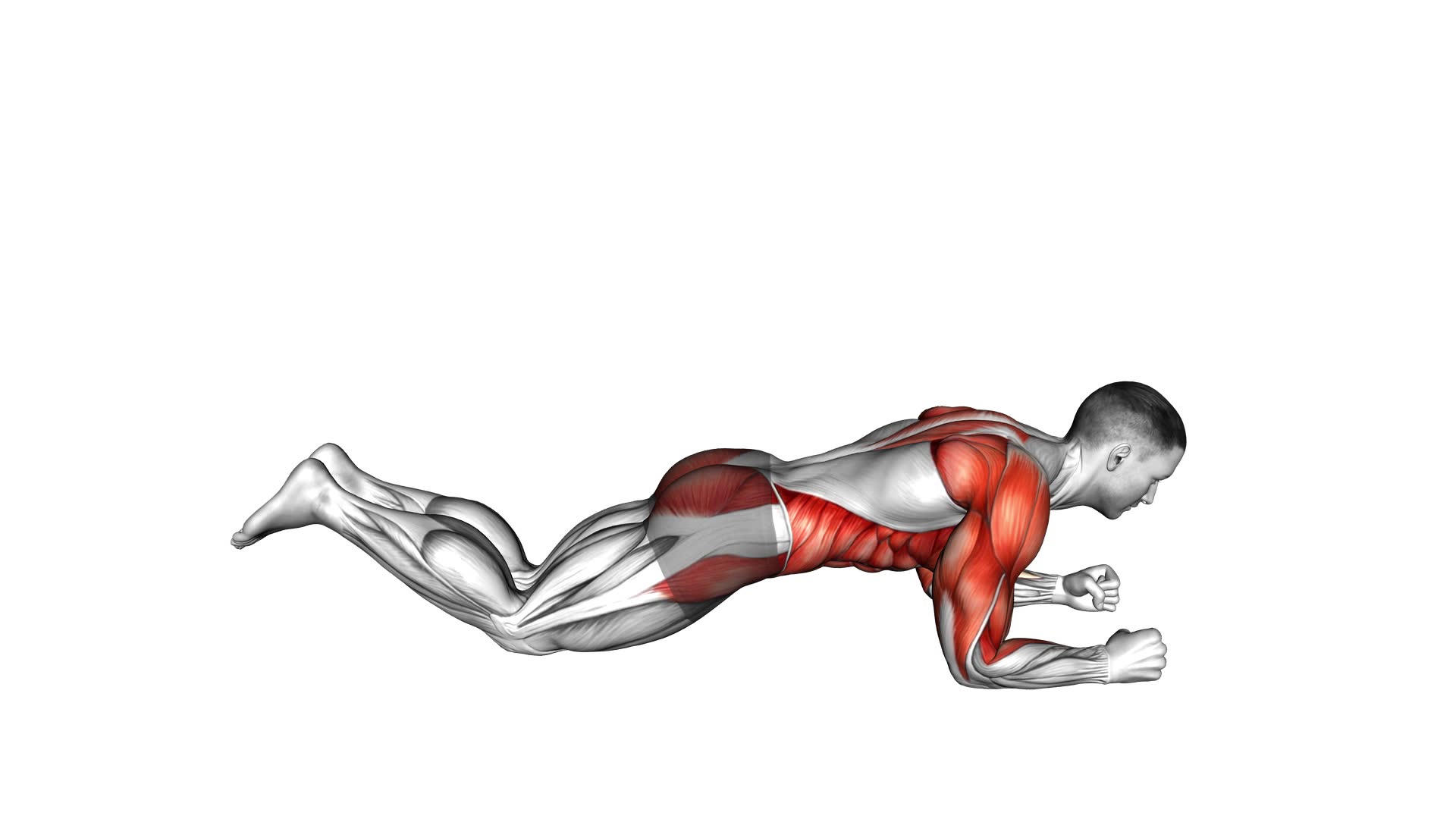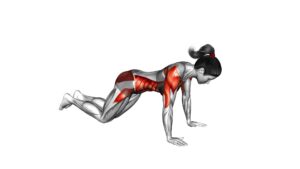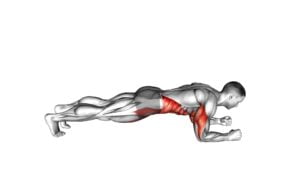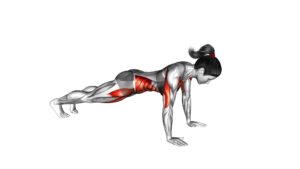Kneeling Dynamic Plank (male) – Video Exercise Guide & Tips

Are you ready to take your core strength to the next level? Get ready to try the Kneeling Dynamic Plank!
Watch This Exercise Video
In this video exercise guide, we'll show you how to properly perform this challenging move. You'll also learn about common mistakes to avoid and modifications for different fitness levels.
By incorporating the Kneeling Dynamic Plank into your workout routine, you'll be on your way to a stronger and more stable core.
Let's get started!
Key Takeaways
- The Kneeling Dynamic Plank strengthens the core and improves overall body strength.
- Engaging multiple muscle groups simultaneously, including abs, back, shoulders, and arms.
- Proper form and technique, such as breathing deeply and maintaining a neutral spine, are crucial for maximizing benefits and preventing injuries.
- Modifications and variations are available for different fitness levels, allowing individuals to gradually progress and build strength and stability.
Benefits of the Kneeling Dynamic Plank
Get ready to experience the numerous benefits of the Kneeling Dynamic Plank. This exercise is a powerful way to strengthen your core, improve stability, and enhance overall body strength. One of the major benefits of the Kneeling Dynamic Plank is that it engages multiple muscle groups simultaneously, including your abs, back, shoulders, and arms. By activating these muscles, you can improve your posture and balance.
Additionally, the Kneeling Dynamic Plank offers a range of modifications and variations to suit different fitness levels and goals. If you're a beginner, you can start by performing the exercise on your knees instead of your toes. This modification reduces the intensity while still allowing you to engage your core muscles effectively. On the other hand, if you're looking for a challenge, you can try adding variations such as knee tucks or mountain climbers to increase the difficulty and target different muscle groups.
By incorporating the Kneeling Dynamic Plank into your workout routine, you'll not only strengthen your core but also improve your overall functional fitness. This exercise is a fantastic way to develop stability and build a strong foundation for other exercises and activities.
Proper Form and Technique for the Exercise
To ensure proper form and technique for the Kneeling Dynamic Plank, it's important that you maintain a strong and stable position throughout the exercise. Here are some key tips to keep in mind:
- Focus on your breathing: Proper breathing is essential during the Kneeling Dynamic Plank. Inhale deeply through your nose as you prepare to lower your body, and exhale through your mouth as you push yourself back up. This will help you engage your core muscles and maintain stability throughout the exercise.
- Maintain a neutral spine: Keep your back straight and your hips in line with your shoulders. Avoid sagging or arching your lower back, as this can put unnecessary strain on your spine and lead to injuries.
- Progress gradually: As you become more comfortable with the Kneeling Dynamic Plank, you can gradually increase the difficulty. Start by holding the plank for a shorter duration and then gradually work your way up to longer periods. You can also add variations, such as lifting one leg or arm, to challenge your stability further.
- Listen to your body: Pay attention to how your body feels during the exercise. If you experience any pain or discomfort, modify the movement or take a break. It's important to prioritize safety and avoid pushing yourself too hard.
By following these tips and practicing proper form and technique, you can maximize the benefits of the Kneeling Dynamic Plank and achieve a strong and stable core.
Keep challenging yourself and enjoy the progress you make over time!
Common Mistakes to Avoid During the Kneeling Dynamic Plank
To perform the Kneeling Dynamic Plank with proper form and technique, it's important to focus on maintaining proper body alignment and engaging your core muscles. Avoid common mistakes such as sagging or arching your back, as this can put unnecessary strain on your spine.
Keep your body in a straight line from head to knees, and actively contract your abdominal muscles to ensure stability and maximize the effectiveness of the exercise.
Stay mindful of these key points to get the most out of your Kneeling Dynamic Plank.
Proper Body Alignment
Ensure proper body alignment during the kneeling dynamic plank by maintaining a straight spine and engaging your core muscles. Here are four common mistakes to avoid in order to achieve optimal body alignment and maximize the effectiveness of your workout:
- Arching your back: Keep your back flat and avoid any excessive arching. This will help protect your spine and engage your abdominal muscles.
- Drooping your hips: Maintain a straight line from your head to your knees. Avoid letting your hips drop towards the ground, as this can put strain on your lower back.
- Rounding your shoulders: Keep your shoulders pulled back and down, away from your ears. This will help activate your upper body muscles and maintain proper alignment.
- Allowing your head to drop: Keep your head in line with your spine, looking down at the ground. Avoid tucking your chin or letting your head hang forward.
By focusing on proper body alignment and core engagement, you won't only improve the effectiveness of the kneeling dynamic plank but also reduce the risk of injury and achieve better results.
Stay mindful of these common mistakes and strive for proper form in every rep.
Engaging Core Muscles
Avoid these common mistakes when engaging your core muscles during the kneeling dynamic plank.
Properly engaging your core is essential for building core strength and stability during this exercise. One common mistake isn't fully activating your core muscles, which can lead to a lack of stability and potential injury.
To engage your core correctly, focus on pulling your belly button towards your spine and tightening your abdominal muscles.
Another mistake to avoid is holding your breath. Remember to breathe steadily throughout the exercise to maintain oxygen flow and prevent unnecessary tension.
Lastly, avoid relying solely on your arms for support. Instead, actively engage your core to distribute the weight evenly and strengthen your entire body.
Modifications and Variations for Different Fitness Levels
Now that you've learned about the common mistakes to avoid during the kneeling dynamic plank, let's discuss some modifications and variations to cater to different fitness levels.
If you're a beginner, we've got you covered with modifications that will help you build strength and stability.
For those looking for a challenge, we'll show you some advanced variations to take your plank game to the next level.
And don't worry, we'll also talk about how to adapt the exercise for different abilities, ensuring that everyone can benefit from this dynamic plank variation.
Beginner Modifications Explained
To modify the kneeling dynamic plank exercise for beginners, start by positioning yourself on your hands and knees. Here are four beginner modifications to help you ease into this challenging exercise:
- Knee-supported plank: Begin by placing your forearms on the ground, with your knees on the mat. This modification reduces the amount of weight you have to support, making it easier to maintain proper form.
- Shoulder taps: While in the plank position, lift one hand off the ground and tap the opposite shoulder. This variation adds a stability challenge without putting too much strain on your core.
- Arm lifts: Start in the plank position and lift one arm straight out in front of you. Hold for a few seconds, then switch arms. This modification helps improve overall balance and strengthens your shoulders.
- Alternating knee taps: From the plank position, slowly lower one knee towards the ground and tap it lightly. Alternate sides for a great core and hip stability workout.
Incorporating these beginner modifications into your sample workout routine will allow you to gradually build strength and improve your stability. Remember to focus on maintaining proper form and listen to your body to avoid any unnecessary strain.
Keep pushing yourself, and before you know it, you'll be ready to tackle the full kneeling dynamic plank exercise!
Challenging Variations for Advanced
Try incorporating these challenging variations into your kneeling dynamic plank exercise to take your fitness to the next level.
Advanced modifications and advanced core exercises can help you push your limits and achieve greater strength and stability.
One challenging variation is the single-leg kneeling dynamic plank, where you lift one leg off the ground while maintaining a strong plank position.
Another option is the kneeling dynamic plank with arm reach, where you reach one arm forward while keeping your core engaged.
For an even greater challenge, try the kneeling dynamic plank with leg lift and arm reach, combining both variations.
These advanced modifications will challenge your balance, coordination, and overall core strength, helping you reach new levels of fitness.
Adapting for Different Abilities
To adapt for different abilities, consider incorporating modifications and variations based on your fitness level. Here are four adaptation techniques that can help you progress or regress the Kneeling Dynamic Plank exercise:
- Progressions: If you find the exercise too easy, you can try the Full Dynamic Plank by extending your legs into a traditional plank position. This will increase the intensity and engage more muscles in your core and upper body.
- Regressions: If the exercise is too challenging, you can start by performing the Kneeling Plank on your forearms instead of your hands. This will provide more stability and make it easier to maintain proper form.
- Modified Range of Motion: Adjust the range of motion by bending your knees slightly or reducing the time you hold the plank. This allows you to gradually build strength and endurance.
- Implementing Stability Tools: Utilize stability tools such as an exercise ball or Bosu ball to add an extra challenge to the exercise. These tools require more balance and stability, helping you improve your overall strength and coordination.
Tips for Maximizing the Effectiveness of the Exercise
To maximize the effectiveness of the exercise, focus on engaging your core muscles and maintaining proper form. This will help you get the most out of each repetition and see better results. Engaging your core muscles means tightening your abdominal muscles while performing the Kneeling Dynamic Plank. This won't only strengthen your core, but also help stabilize your body during the exercise.
Another tip for maximizing the effectiveness of the exercise is to track your progress. Keeping a record of your workouts can help you see how far you've come and motivate you to push harder. You can track the number of repetitions you do, the duration of each plank, or even the level of difficulty you're able to achieve.
Remember to always listen to your body and take breaks when needed. It's better to perform the exercise with proper form and take breaks when necessary, rather than push through with poor form and risk injury.
Sample Workout Routine Incorporating the Kneeling Dynamic Plank
Now that you have learned about maximizing the effectiveness of the Kneeling Dynamic Plank, let's dive into a sample workout routine that incorporates this exercise.
Here is a workout routine that will help you progress in core strength and incorporate the Kneeling Dynamic Plank:
- Warm-up: Start with 5-10 minutes of light cardio to get your blood flowing and muscles warmed up.
- Kneeling Dynamic Plank: Begin with 3 sets of 10 repetitions, focusing on maintaining proper form and engaging your core muscles. As you become more comfortable, increase the sets and repetitions.
- Superset: Pair the Kneeling Dynamic Plank with exercises such as Russian twists or mountain climbers to further challenge your core stability and increase the intensity of your workout.
- Workout Modifications: If the Kneeling Dynamic Plank becomes too easy, you can progress by adding a leg lift or a knee tuck while maintaining the plank position. This will engage your core muscles even more and provide an additional challenge.
Remember to listen to your body and adjust the workout routine based on your fitness level. With consistency and dedication, you'll gradually build core strength and see improvements in your overall fitness. Keep pushing yourself and enjoy the journey!
Frequently Asked Questions
How Many Calories Can I Burn by Doing the Kneeling Dynamic Plank?
Incorporating the kneeling dynamic plank into your workout routine has numerous benefits.
Not only does it engage your core muscles, but it also strengthens your arms, shoulders, and back.
This exercise can help improve your posture and stability.
As for variations and modifications, you can adjust the difficulty level by changing the duration or adding weights.
Remember, consistency and proper form are key to getting the most out of this exercise.
Can the Kneeling Dynamic Plank Help Improve My Posture?
Improving your posture is important for overall health and confidence.
The kneeling dynamic plank can be a helpful exercise for achieving better posture. By engaging your core and stabilizing your body, this exercise strengthens the muscles in your back and abdomen, which can lead to improved posture over time.
Additionally, if you suffer from knee pain, the kneeling position can provide a modified version of the plank that puts less stress on your joints.
Keep up the good work!
Is It Normal to Feel Soreness in My Lower Back After Performing the Kneeling Dynamic Plank?
Feeling soreness in your lower back after doing the kneeling dynamic plank isn't uncommon. This exercise engages your core, including the muscles in your lower back, which can lead to some discomfort.
However, if the pain is severe or persists, it's important to modify the exercise or consult a professional. Beginners can try modifying the plank by keeping their knees on the ground or shortening the duration.
Can the Kneeling Dynamic Plank Be Beneficial for Someone With Knee Pain?
The kneeling dynamic plank can be beneficial for someone with knee pain. By engaging your core muscles and stabilizing your body, it helps to strengthen your entire core without putting excessive stress on your knees.
If you experience knee pain during this exercise, you can modify it by performing alternative core exercises such as seated knee tucks or standing oblique twists. Remember to listen to your body and consult with a professional if needed.
Keep pushing yourself, you got this!
How Long Should I Hold the Kneeling Dynamic Plank to See Results?
To see results from the kneeling dynamic plank, focus on proper form and technique. Start with holding the plank for 15-30 seconds, gradually increasing the time as you build strength and endurance. Aim for 3-5 sets, 2-3 times a week.
Consistency is key! As you progress, try different dynamic plank variations to challenge your muscles in new ways. Remember to listen to your body and take breaks if needed, but push yourself to reach your goals.
You got this!
Conclusion
Incorporating the kneeling dynamic plank into your workout routine can offer a range of benefits, including improved core strength, stability, and overall body control.
By maintaining proper form and avoiding common mistakes, you can maximize the effectiveness of this exercise.
Remember to listen to your body and adjust the intensity as needed, using modifications or variations to suit your fitness level.
Stay consistent and motivated, and you'll soon see the positive results of this challenging yet rewarding exercise.

Author
Years ago, the spark of my life’s passion ignited in my mind the moment I stepped into the local gym for the first time. The inaugural bead of perspiration, the initial endeavor, the very first surge of endorphins, and a sense of pride that washed over me post-workout marked the beginning of my deep-seated interest in strength sports, fitness, and sports nutrition. This very curiosity blossomed rapidly into a profound fascination, propelling me to earn a Master’s degree in Physical Education from the Academy of Physical Education in Krakow, followed by a Sports Manager diploma from the Jagiellonian University. My journey of growth led me to gain more specialized qualifications, such as being a certified personal trainer with a focus on sports dietetics, a lifeguard, and an instructor for wellness and corrective gymnastics. Theoretical knowledge paired seamlessly with practical experience, reinforcing my belief that the transformation of individuals under my guidance was also a reflection of my personal growth. This belief holds true even today. Each day, I strive to push the boundaries and explore new realms. These realms gently elevate me to greater heights. The unique combination of passion for my field and the continuous quest for growth fuels my drive to break new ground.







